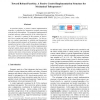118 search results - page 15 / 24 » Why computerized models to control virtual Humans |
ATAL
2008
Springer
13 years 9 months ago
2008
Springer
We discuss the design of the Intermediary Agent's brain, the control module of an embodied conversational virtual peer in a simulation game aimed at providing learning experi...
ATAL
2008
Springer
13 years 9 months ago
2008
Springer
Humans continuously assess one another's situational context, modify their own affective state, and then respond based on these outcomes through empathetic expression. Virtua...
ENGL
2007
13 years 7 months ago
2007
—Realistic motion and natural-looking simulations require a thorough understanding of human movement control strategies. This work presents an initial developed on virtual agents...
HAPTICS
2003
IEEE
14 years 28 days ago
2003
IEEE
In previous papers, a passive control implementation structure is proposed for mechanical systems interacting with physical environments. The proposed implementation structure enf...
HAPTICS
2005
IEEE
14 years 1 months ago
2005
IEEE
In this paper we propose a new set of primitives to realize a large-area covering realistic tactile display. They stimulate the skin surface with suction pressure (SPS method) as ...



